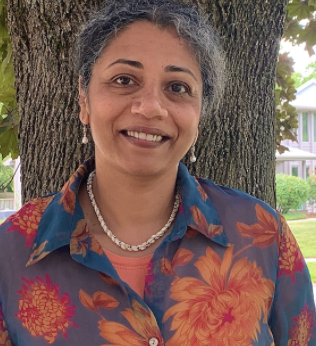Physical Distance, Digital Connection: Building Bridges in Community-based Language Programs
By Sandhya Shanker, Director, Community Language School, Michigan State University, and Elizabeth Ablan, Graduate Assistant, Community Language School, Michigan State University


Whirlwind. Curveball. Whiplash. Unexpected. Unprecedented. These were just a few of the words swirling around as we transitioned to remote instruction at the Community Language School (CLS) at Michigan State University last spring. We were catapulted into the unknown of virtual planning, learning and teaching, forcing us to adapt our programs to offer fully remote language classes for families, kids, pre-teens, teens and adults in just a few short weeks and throughout the summer. In this transitional whirlwind, members of CLS not only grew in digital literacy and remote teaching and learning, but also in re-discovering the power of technology in community building through language learning. Languages have always connected people and now more than ever, despite the new mode of instruction, the love of learning languages continues to provide a space to connect with one another. Reflecting on the move to online teaching and learning, these once insurmountable changes became a catalyst for growth in envisioning community building for all ages in a whole new virtual way.
Setting the Stage for Online Teaching
The MSU Community Language School runs programs in world languages for students ranging from ages three years old to adults. This summer, our language offerings included: Chinese, French, German, Italian, Japanese, and Spanish, and were offered fully online to honor the safety and well-being of our students and families. As we navigated the feasibility of transitioning our program online, we were keenly aware of the multiple stressors our instructors and students were experiencing, and sought to offer timely and adequate support. To address the needs of our instructors, a survey was conducted at the beginning of the transition period. The data collected was used to make informed decisions about the structure of our programming and identify specific areas of support such as digital literacy and remote language instruction.
As a community-based language program we are continually looking for ways to connect with others and facilitate opportunities for cultural awareness and language learning. The flexible nature of our program allows CLS to adapt to the evolving needs of the community. Leading up to our summer transition, like many programs and classrooms around the world, we were given the opportunity to pause and reflect on our principal values that drive our programs forward in the context of the current circumstances of the pandemic. This time of reflection allowed us to reevaluate our four pillars and reimagine how they would be used to guide our programming decisions in transitioning the Community Language School fully online: youth engagement, peer interaction, fostering a supportive environment and providing a safe environment. These values continued to cast a vision forward and shaped our engagement in the community as we navigated making new connections through technology. Anticipating online instruction as a novel experience for instructors and students alike, we intentionally identified only the essential technology requirements to run our online programs. We recognized the delicate balance that technology plays; while it can open doors for some, accessing a program fully online could also be a barrier to others. Additionally, within the classroom, we found it challenging to walk the thin line of offering the bountiful, rich technology resources and incorporating these thoughtfully and effectively into our programs, while still upholding our guiding pillars.
Youth Engagement
Since its inception, CLS has strived to provide opportunities to engage youth in learning a language through after-school programs, evening classes and summer language camps. In an effort to connect with youth and continue providing language learning opportunities, the decision was made to deliver all CLS online youth programming synchronously via Zoom this summer. We were also guaranteed institutional support through MSU to set up our classes on Zoom and troubleshoot any tech-related issues. The online platform forced us to completely re-conceptualize youth engagement and make adjustments to structures and routines in a number of areas that we had set in place with our in-person programming.
Establishing a classroom community is a challenging feat for any teacher; however, building these relationships with students online adds a new dynamic and frame of reference to orient one’s teaching. We understand that building a classroom community does not always organically materialize, rather it requires considerable planning and preparation. With this approach in mind, we strategically planned ways to foster community beginning with the first point of contact with students to take place via a virtual Zoom “Meet and Greet” prior to the first day of class. During this introductory online session, instructors introduced themselves and their volunteers to their students. Instructors used this time to facilitate short icebreakers to help get to know their future students and begin building a classroom community. The “Meet and Greet” also provided the space to lay the foundation for digital literacies ranging from teaching students how to mute/unmute oneself, using the chat feature and participating in a Zoom breakout room. Instructors continued the intentionality of community building throughout the lessons both synchronously and asynchronously through thoughtfully planned lessons and extension materials and activities.
- Synchronous Engagement: Our weekly 30-minute classes focused on presenting key vocabulary and phrases as well as providing a good blend of interactive and communicative activities to reinforce the target vocabulary. Oftentimes, CLS instructors would bring props and realia to a lesson to help reinforce vocabulary during face to face instruction; however, in order to compensate for the physical distance, many instructors creatively worked around it by inviting students to bring their own props and realia to their online classes. Some examples included bringing a fork, spoon, napkin and plate to a lesson on place settings and their favorite snack when talking about food preferences. Instructors also played scavenger hunt games asking students to count the number of windows or identify different rooms in their home. Additionally, quick five minute screen breaks were utilized to help break up the longer stretches in front of the computer.
- Asynchronous Engagement: To continue engaging students beyond the synchronous classes, CLS instructors provided video summaries after each live session lesson to help reinforce vocabulary and pronunciation. These videos were shared with parents through a classroom Google folder as well as additional resources such as YouTube video links, handouts, and virtual flashcards. The weekly videos and supplemental materials were excellent resources for students and families alike. For our older participants in the pre-teen/teen programs, students were paired up to be conversation partners and encouraged to practice short conversations in the target language that reinforced the lesson’s key vocabulary and phrases. Students were also assigned short video projects on Flipgrid, for example, narrating and demonstrating how they make their favorite sandwich in the target language.
These digital literacies helped students transition to the synchronous online classes and increased their engagement. All these details contributed to creating a strong classroom community and set the tone for a long-term and sustaining relationship that encourages students to continue their language learning experience with CLS.
Peer Interaction
Peer interaction constitutes a crucial component of our language classes. Activities that focus on interaction not only reinforce a student’s own understanding of the material but also inform the instructor about how language input is received and processed by students. It also promotes active learning among students through the use of tasks that encourage students to think and analyze the information thereby helping them make connections between daily lived experiences and language learning. Active learning provides a baseline to help students critically reflect and ultimately help make the transition from discussing topics that are concrete to expressing ideas at the abstract level.
In aligning ourselves with this objective, our online curriculum was designed around students’ ‘here and now’ experiences, given that COVID-19 had forced everyone to stay home. Our family classes, for kids ages 3-9 years old, included topics such as family, house, games, snack time, and the neighborhood. For kids 10-14 years old, topics suited for this age group included chores, cooking, fashion, music genres and career options. To encourage active learning, our instructors incorporated questions about likes and dislikes (utilizing the reaction buttons on Zoom), frequency of doing certain activities, often using Zoom polls to get quick data on student perceptions and preferences.
Our instructors set clear expectations for peer interaction in a virtual environment by establishing ground rules, e.g. regulating the use of the mute/unmute, video on/off, chat, poll and reaction button features on Zoom. Volunteers also assisted with ensuring that every student had a turn to speak/respond as well as enforcing communication protocols in breakout rooms. This kind of facilitation via Zoom enhanced students’ abilities to actively listen and dialogue effectively with their peers.
Creating a Safe and Supportive Environment
Ensuring a safe and supportive environment for our staff and learners is of paramount importance in our programs. Remote office hours for CLS instructors were set up and hosted by CLS administrators to provide an additional layer of support for our novice online instructors. Teachers could get help navigating the new classroom dynamics of online instruction, and share candidly about their challenges and successes in lesson planning and classroom management. These collaborative sessions brought new insights and perspectives in a safe manner that enhanced the instructor’s remote teaching skills and helped build a community of practice.
With the move to a virtual environment, there was an even greater need to promote online safety and safeguard the privacy of our participants. This process started with the recruitment of volunteers for our online programs. MSU’s youth programming policies mandated that a minimum of 3 volunteers be recruited for each class. The main duties of the volunteers were to supervise the students (in the main session and breakout rooms), and monitor the chat as well as online interpersonal behavior. Each program had a unique Zoom link and password that was sent out to parents and guardians of the students. While the sharing of the Google folder with materials was a minimum requirement, we also encouraged teachers to explore some of MSU’s recommended platforms (e.g. Kahoot, Flipgrid and Quizlet) as they saw fit. Teachers were asked to keep safety recommendations in mind when creating videos for their classes. For instance, if they created them on YouTube, they needed to adhere to the following recommendations:
- Publish videos as “unlisted” rather than “public” and distribute the links.
- Disable or monitor comments closely.
- Do not share links to unlisted videos in a public place such as a website. Share links only with registered participants.
- Do not include identifiable images of current or former program participants in videos.
Conclusion
The mission and vision of CLS is to provide rich language learning opportunities for the Greater Lansing community and beyond. The transition to online classes broadened our impact and reach to language learners from around the country. We were also able to successfully harness technology to uphold the guiding pillars of our programming. While we certainly faced challenges when making the transition to online learning, the benefits seemed to far outweigh the challenges. Participants in our summer programs reported proficiency gains in both online literacy and oral language skills.
During a time of extreme physical distance, the CLS online language classes provided an outlet for students to interact with others and grow in their knowledge of language and culture. Bringing students together who wanted to learn a new language and culture also provided a form of socialization where students could interact with others outside their family. Given the constant fluctuations and unknowns brought on by the pandemic, these weekly classes provided consistency and structure for students to get to know one another and to share in their love of language learning. In a time where physical distancing limited our interactions for safety reasons, thanks to technology, we were able to bridge the distance digitally by channeling students’ love of language learning to foster community and social connection.

